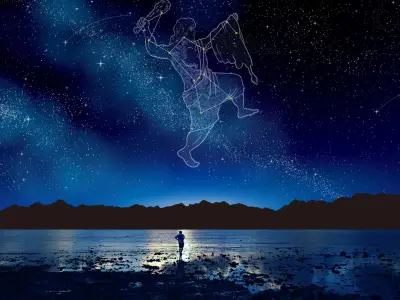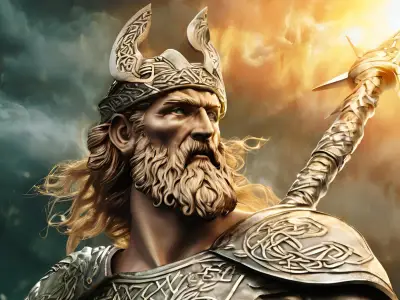In ancient Egyptian mythology, the celestial tales of the stars often revolve around Nut, the goddess of the sky. This blog post explores who Nut is, her myths and legends, symbols, powers, relationships, and legacy.
Jump to:
Who is Nut in Egyptian Mythology?
Nut is the Egyptian goddess of the sky, a central figure in the pantheon of ancient Egyptian deities. She embodies the heavens and is considered the personification of the sky itself. Nut is usually depicted as a woman arching over the earth, her body adorned with stars, symbolising her domain over the night sky.
Recommended for you!
Best SellersWhat is Nut the God of?
Nut is primarily the goddess of the sky. She plays a role in maintaining the balance of the universe by separating the chaotic waters of Nun from the orderly world below. Nut's responsibilities include swallowing the sun god Ra each evening and giving birth to him each morning, thus controlling the cycle of day and night.
The Myths and Legends of Nut

Nut is surrounded by captivating myths that explain her divine role and her relationships with other gods. Let's explore the key legends that highlight Nut's importance in Egyptian mythology.
The Birth of Nut's Children
According to Egyptian mythology, Nut is the daughter of Shu, the god of air, and Tefnut, the goddess of moisture. She is married to her brother Geb, the god of the earth. Ra, the sun god, cursed Nut to prevent her from giving birth on any day of the year, fearing a prophecy that one of her children would overthrow him. However, Thoth, the god of wisdom, devised a clever plan. He gambled with the moon god Khonsu, winning enough moonlight to create five extra days. These days, known as the Epagomenal Days, allowed Nut to give birth to five children: Osiris, Isis, Set, Nephthys, and Horus the Elder.
Nut and Ra
Each evening, Nut swallows Ra as he travels through her body during the night. By morning, she gives birth to him again, symbolising the dawn. This daily cycle represents the eternal renewal and rebirth, a fundamental concept in Egyptian mythology.
The Separation of Geb and Nut
Ra ordered Shu to separate Nut and Geb, creating the space necessary for life to thrive between the sky and the earth. Shu held Nut high above Geb, preventing them from being together and maintaining cosmic order.
The Symbols of Nut
Nut's symbols reflect her divine role as the goddess of the sky. Each symbol carries deep significance and highlights different aspects of her celestial responsibilities.
- Woman Arching Over the Earth: Nut is often depicted as a woman arching over the earth, her body adorned with stars. This imagery represents the night sky and emphasises her role in enveloping the world with her protective embrace.
- Cow: Sometimes, Nut is portrayed as a cow, symbolising her nurturing qualities. The cow form also underscores her connection to fertility and the life-giving aspects of the sky.
- Stars: The stars covering Nut's body are a direct representation of the night sky. They symbolise her control over celestial phenomena and her role in the cosmic order.
- The Milky Way: Nut is associated with the Milky Way, often seen as the celestial river flowing through the night sky. This connection highlights her expansive and all-encompassing nature as the sky goddess.
What Powers Does Nut Have?

Nut's powers are extensive and reflect her role in maintaining the balance of the universe. Her abilities are vast and impactful, both in the celestial realm and in the world below.
- Control of Day and Night: Nut controls the cycle of day and night by swallowing and rebirthing the sun god Ra. This power ensures the continual renewal and balance of time.
- Protection and Nurturing: As a sky goddess, Nut has the power to protect and cover the earth. Her nurturing abilities are essential for maintaining life and providing a safe and ordered environment.
- Cosmic Order: Nut ensures the order of the universe by keeping the chaotic waters of Nun at bay. Her presence maintains the separation between the heavens and the earth, preserving the harmony of the cosmos.
Nut's Relationships, Children, and Family Tree
Nut's Parents and Siblings
Nut is the daughter of Shu, the god of air, and Tefnut, the goddess of moisture. Her siblings include Geb, the earth god, with whom she shares a unique and powerful bond.
The Divine Union: Nut and Geb's Relationship
At the heart of Nut’s mythological narrative is her union with Geb, the god of the earth. This divine relationship represents the intimate connection between the sky and the earth, a powerful symbol of cosmic unity.
Despite their bond, the relationship between Nut and Geb is marked by separation. Ordered by Ra and enforced by Shu, the god of air, Nut and Geb are kept apart to maintain the balance of the universe. This separation is both a physical and symbolic act, ensuring the space necessary for life to exist between the sky and the earth.
Their love, though physically divided, remains a powerful representation of the intertwined destinies of the heavens and the earth. The separation is essential for the cosmic order, illustrating the sacrifices made for the greater good of creation.
Offspring of Nut and Geb
The children of Nut and Geb are among the most significant deities in Egyptian mythology, each embodying different aspects of the divine realm and human existence.
- Osiris, the God of the Afterlife: Osiris is perhaps the most well-known of Nut and Geb’s children. As the god of the afterlife, he represents death, resurrection, and the promise of eternal life. Osiris’s story, particularly his murder by Set and resurrection by Isis, is central to Egyptian beliefs about life after death.
- Isis, the Goddess of Magic and Motherhood: Isis is the epitome of magic, healing, and motherhood. Her dedication to her husband Osiris and her son Horus highlights her role as a protector and nurturer. Isis’s powers and her role in the resurrection of Osiris make her one of the most respected deities in Egyptian mythology.
- Set, the God of Chaos and Desert Storms: Set is the god of chaos, violence, and desert storms. His tumultuous nature often puts him in opposition to his siblings, particularly Osiris and Horus. Set’s role as an antagonist in many myths highlights the duality of order and chaos in the universe.
- Nephthys, the Goddess of Mourning and Protection: Nephthys is associated with mourning, protection, and the afterlife. Though often overshadowed by her more prominent siblings, she plays a role in the myth of Osiris, assisting Isis in his resurrection and protecting the deceased in the afterlife.
- Horus the Elder, the God of the Sky: Horus the Elder is a sky god associated with protection and kingship. Distinct from Horus the Younger (the son of Isis and Osiris), Horus the Elder represents the celestial aspect of Nut’s domain and the protective qualities of the sky.
Nut's Worship and Legacy

Although not as worshipped as some of the other deities, Nut’s role as the goddess of the sky and protector of the earth ensured that her worship and legacy endured through the centuries.
Temples of Nut in Egypt
While Nut did not have large temples dedicated solely to her, her presence was significant in many temple complexes and smaller shrines. Her images and depictions were often featured alongside other major deities, reflecting her importance in maintaining cosmic order. One notable site where Nut was worshipped is the Temple of Hathor at Dendera, where her images can be found among other protective and nurturing deities.
Statues and Depictions of Nut
Statues and depictions of Nut have been discovered throughout Egypt, often in temple settings and on tomb walls. These images typically show her arching over the earth, her body adorned with stars, representing her domain over the sky. The unique artistry of these depictions highlights her importance in the cosmic balance and her role in the renewal of life.
These statues and images served as powerful symbols of protection and continuity, believed to embody Nut’s presence and ensure the order of the universe. They were placed in prominent locations to invoke her protective and nurturing essence.
Making Offerings to Nut
To honour Nut, ancient Egyptians made various offerings to invoke her protection and blessings. These offerings often included food, drink, flowers, and symbolic items such as small statues or amulets. Common offerings included bread, beer, and water, reflecting Nut’s nurturing and life-sustaining nature.
In modern times, those who feel a connection to Nut might offer symbols of renewal and protection, such as flowers, candles, or figurines representing the sky. Creating a small altar with images of Nut, along with celestial symbols and stones associated with her energy, like lapis lazuli and star sapphire, is a way to connect with her celestial and protective essence.
Recommended for you!
Best SellersFrequently Asked Questions About Nut
What Did Nut the Goddess of the Sky Do Every Evening?
Every evening, Nut swallows Ra, the sun god, as he journeys through her body during the night. By morning, she gives birth to him again, symbolising the dawn and the daily cycle of renewal.
How Did Ancient Egyptians Represent the Sky Goddess Nut?
Ancient Egyptians depicted Nut as a woman arching over the earth, her body covered in stars, or as a cow. These representations emphasise her role as the goddess of the sky and her connection to the night and celestial bodies.
Why Did Ra Curse Nut?
Ra cursed Nut to prevent her from giving birth on any day of the year, driven by his fear of a prophecy that one of her children would overthrow him. This curse was overthrown by Thoth’s clever intervention.
How Did Thoth Help Nut Break This Curse?
Thoth gambled with the moon god Khonsu, winning extra light and creating five additional days outside the regular 360-day year. These days allowed Nut to give birth to her children, despite Ra’s curse.
Is Horus the Son of Nut or Isis?
Horus the Elder is one of Nut’s children. However, the more commonly known Horus, Horus the Younger, is the son of Isis and Osiris, who are Nut’s children.
Why Were Geb and Nut Separated?
Geb and Nut were separated by Shu, the god of air, under Ra’s orders. This separation was necessary to create space for life to exist between the sky and the earth, maintaining the cosmic order.
Study Egyptian Mythology for £29
If you’ve found Nut’s story intriguing and want to learn more about Egyptian gods and goddesses, consider enrolling in the Egyptian Mythology Diploma Course at Centre of Excellence. This fascinating course is available at a discounted price of £29 and offers an in-depth exploration of the rich and captivating ancient Egyptian culture.













